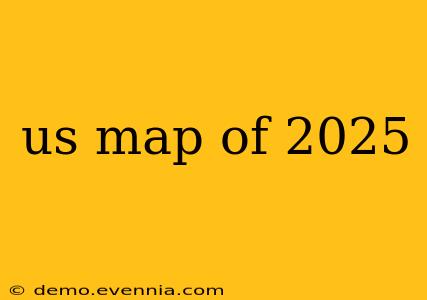Predicting the US Map of 2025: A Shifting Landscape of Demographics, Politics, and Infrastructure
The United States is a nation in constant flux, a dynamic tapestry woven from shifting demographics, evolving political landscapes, and ever-changing infrastructure. Predicting the "US map of 2025" isn't about drawing new lines on a static image; it's about understanding the powerful forces reshaping the nation and extrapolating their likely impact. While we can't definitively draw a future map, we can analyze key trends to paint a plausible picture.
1. Demographic Shifts: A Changing American Identity
The US population continues its evolution. By 2025, we can expect:
- Increased Urbanization: Mega-cities will continue to grow, while rural areas may experience population decline or stagnation. This trend will intensify the already existing urban-rural divide in terms of resources, infrastructure, and political representation.
- Shifting Racial and Ethnic Demographics: The nation will become increasingly diverse, with minority populations growing significantly. This demographic shift will undoubtedly impact political representation and cultural dynamics across the country. The Southwest and Southeast will likely experience the most dramatic changes.
- Aging Population: The older population segment will continue to expand, placing increasing strain on healthcare systems and social security programs. This will necessitate significant changes in healthcare infrastructure and long-term care facilities nationwide.
2. Political Polarization and its Geographical Manifestations:
Political polarization, a defining characteristic of recent years, will likely persist into 2025. This translates into a geographically fragmented nation, with:
- Reinforced Political Blocs: States with strong Republican or Democrat leanings will likely solidify their positions, resulting in less political fluidity across regions. This could manifest in differing policy approaches, impacting everything from environmental regulations to education.
- Increased Regionalism: The emphasis on local and regional identity may grow stronger, potentially leading to more localized political movements and a decreased focus on national unity.
- Electoral Map Volatility: While predicting specific election outcomes is impossible, the fluidity within some swing states could continue to make election results unpredictable.
3. Infrastructure Investments and Their Impact:
Infrastructure development plays a pivotal role in shaping geographical landscapes:
- Transportation Networks: Investment (or lack thereof) in transportation infrastructure will influence economic growth and population distribution. Areas with improved transportation access might experience increased economic activity and population growth, while others might lag behind.
- Energy Infrastructure: The transition to renewable energy sources might lead to the development of new energy hubs and the decline of traditional fossil fuel-dependent regions. This shift could significantly alter the economic and environmental landscapes.
- Technological Infrastructure: Access to high-speed internet and other technological advancements will become even more crucial. Areas with robust digital infrastructure will be better positioned for economic growth and opportunity, while areas lacking access may face a widening digital divide.
4. Climate Change's Unfolding Influence:
Climate change's effects will likely become increasingly apparent by 2025, influencing the US map in several ways:
- Coastal Erosion and Sea-Level Rise: Coastal communities will face significant challenges from rising sea levels and increased storm intensity, potentially requiring large-scale relocation and infrastructure adaptation.
- Extreme Weather Events: Increased frequency and severity of droughts, floods, wildfires, and heatwaves will impact agriculture, water resources, and public health across various regions.
- Environmental Migration: Climate change-induced environmental disasters could spur internal migration patterns as people seek safer and more habitable environments.
Conclusion:
The "US map of 2025" isn't a static image; it's a dynamic system shaped by interacting forces. While pinpointing exact changes is impossible, understanding these key demographic, political, infrastructure, and environmental trends allows us to envision a more nuanced and realistic picture of the nation's evolving geographical landscape. The interplay of these forces will continue to redraw the map, not literally, but figuratively, in terms of political power, economic opportunity, and the very fabric of American life.

